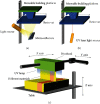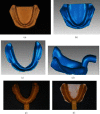A Review of 3D Printing in Dentistry: Technologies, Affecting Factors, and Applications
- PMID: 34367410
- PMCID: PMC8313360
- DOI: 10.1155/2021/9950131
A Review of 3D Printing in Dentistry: Technologies, Affecting Factors, and Applications
Abstract
Three-dimensional (3D) printing technologies are advanced manufacturing technologies based on computer-aided design digital models to create personalized 3D objects automatically. They have been widely used in the industry, design, engineering, and manufacturing fields for nearly 30 years. Three-dimensional printing has many advantages in process engineering, with applications in dentistry ranging from the field of prosthodontics, oral and maxillofacial surgery, and oral implantology to orthodontics, endodontics, and periodontology. This review provides a practical and scientific overview of 3D printing technologies. First, it introduces current 3D printing technologies, including powder bed fusion, photopolymerization molding, and fused deposition modeling. Additionally, it introduces various factors affecting 3D printing metrics, such as mechanical properties and accuracy. The final section presents a summary of the clinical applications of 3D printing in dentistry, including manufacturing working models and main applications in the fields of prosthodontics, oral and maxillofacial surgery, and oral implantology. The 3D printing technologies have the advantages of high material utilization and the ability to manufacture a single complex geometry; nevertheless, they have the disadvantages of high cost and time-consuming postprocessing. The development of new materials and technologies will be the future trend of 3D printing in dentistry, and there is no denying that 3D printing will have a bright future.
Copyright © 2021 Yueyi Tian et al.
Conflict of interest statement
We declare no financial or personal relationships with other people or organizations that can inappropriately influence our work.
Figures











Similar articles
-
Materials and Applications of 3D Printing Technology in Dentistry: An Overview.Dent J (Basel). 2023 Dec 19;12(1):1. doi: 10.3390/dj12010001. Dent J (Basel). 2023. PMID: 38275676 Free PMC article. Review.
-
3D printing in dentistry.Br Dent J. 2015 Dec;219(11):521-9. doi: 10.1038/sj.bdj.2015.914. Br Dent J. 2015. PMID: 26657435 Review.
-
Recent advances in additive manufacturing of patient-specific devices for dental and maxillofacial rehabilitation.Dent Mater. 2024 Apr;40(4):700-715. doi: 10.1016/j.dental.2024.02.006. Epub 2024 Feb 24. Dent Mater. 2024. PMID: 38401992 Review.
-
User Experience and Sustainability of 3D Printing in Dentistry.Int J Environ Res Public Health. 2022 Feb 9;19(4):1921. doi: 10.3390/ijerph19041921. Int J Environ Res Public Health. 2022. PMID: 35206116 Free PMC article.
-
How useful is 3D printing in maxillofacial surgery?J Stomatol Oral Maxillofac Surg. 2017 Sep;118(4):206-212. doi: 10.1016/j.jormas.2017.07.002. Epub 2017 Jul 18. J Stomatol Oral Maxillofac Surg. 2017. PMID: 28732777 Review.
Cited by
-
Digitally fabricated precision attachment with cast partial framework retained obturator in a partial maxillectomy patient following mucormycosis: A case report.Natl J Maxillofac Surg. 2024 May-Aug;15(2):332-336. doi: 10.4103/njms.njms_130_22. Epub 2024 Jul 24. Natl J Maxillofac Surg. 2024. PMID: 39234132 Free PMC article.
-
Redefining precision and efficiency in orthognathic surgery through virtual surgical planning and 3D printing: a narrative review.Maxillofac Plast Reconstr Surg. 2023 Dec 18;45(1):42. doi: 10.1186/s40902-023-00409-2. Maxillofac Plast Reconstr Surg. 2023. PMID: 38108939 Free PMC article. Review.
-
Mechanical property of pixel extrusion and pin forming for polymer, ceramic, and metal formation.Heliyon. 2023 Jan 11;9(1):e12871. doi: 10.1016/j.heliyon.2023.e12871. eCollection 2023 Jan. Heliyon. 2023. PMID: 36711282 Free PMC article.
-
Characterization of Ag-Ion Releasing Zeolite Filled 3D Printed Resins.J Funct Biomater. 2022 Dec 22;14(1):7. doi: 10.3390/jfb14010007. J Funct Biomater. 2022. PMID: 36662054 Free PMC article.
-
Wear Resistance, Color Stability and Displacement Resistance of Milled PEEK Crowns Compared to Zirconia Crowns under Stimulated Chewing and High-Performance Aging.Polymers (Basel). 2021 Oct 30;13(21):3761. doi: 10.3390/polym13213761. Polymers (Basel). 2021. PMID: 34771318 Free PMC article.
References
Publication types
MeSH terms
LinkOut - more resources
Full Text Sources
